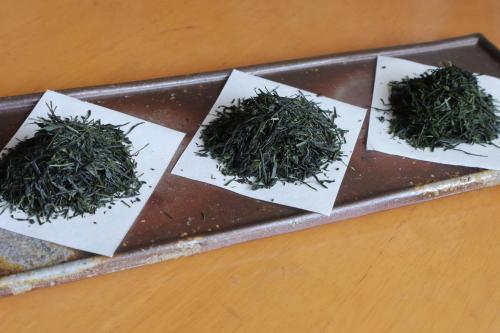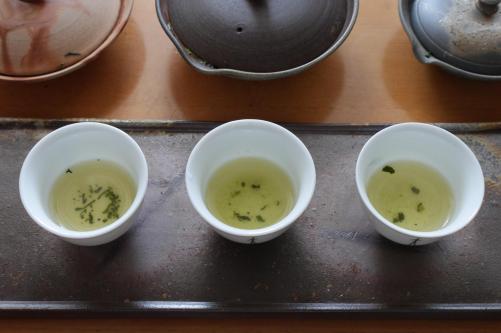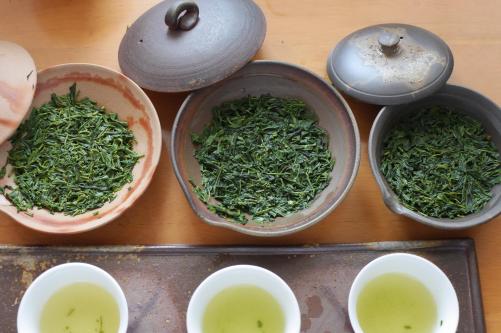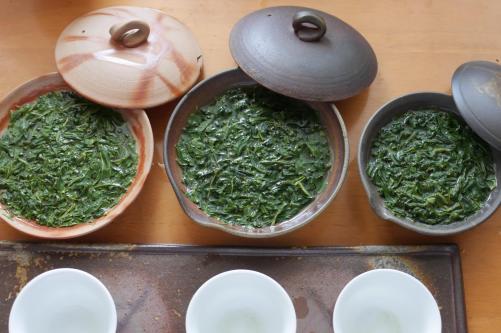As the 2018 season kicks off, here is the perfect opportunity to remember that gyokuro and matcha are usually not sold as shincha, especially in Uji. The teas of the current year thus begin to be sold or used in the fall, these very special teas having a significant need for maturation to see their aromas gain strength and disappear the characteristic shaded teas greenish scent.
The 2017 season was a little disappointing for gyokuro and kabuse-cha in general, with good teas but often lacking their characteristic punch. We cross our fingers to have better in 2018, which should be the case (see you in September for gyokuro so), and in the meantime I offers you three vintage gyokuro from Kyô-tanabe. If this is not in the way for sencha (yet good sencha age very well), it is not so unusual to see “vintage” gyokuro. About these “aged” green teas, it should be understood that if their aromas change, do not wait for radical changes either.

2004, 2009, 2012
I propose you two gyokuro, gokô cultivars by Mr. Yoneta (whose gokô gyokuro have already been presented on Thés du Japon in 2017, 2016 and 2015) from the 2009 and 2012 harvests. Then, I propose a rarer gyokuro, cultivar Kyô-midori by Mr. Dejima from 2004. Kyô-midori is one of the first shaded tea cultivars to be registered in the 1950s. It was isolated of course from a zairai (native) tea plant from Uji.
With these typical fruity and sweet aromas, gokô is one of the most used gyokuro cultivars in Uji. Thus, with these two vintages by Mr. Yoneta, we are in known territory and these two teas can only delight lovers of high-end gyokuro from Uji. In addition, they are however clearly different.

The 2009 is marked by a truly powerful umami and a confectionery scent. Its aromatic profile is rather simple but very characteristic, robust with a very big impact in the mouth. The sweetness, the almost suger drops umami erases any green trace on the first infusion, but the second, the mouth is tinged with a green sensation, but not vegetable, however, typical of highly shaded teas.

Beside, the 2012 is more airy, its umami less strong, more velvety. Less robust, it has more aromatic diversity, with notes of cocoa, old leather, a little woody even. The fruity side of gokô is of course also very present. There is also a vegetable touch in the back.
We probably at the base with this vintage 2012 have a gyokuro less powerful than the 2009, on which a hi-ire (roasting / final drying) a little stronger was done.
The comparison between these two cultivar is really interesting, with two teas from the same plantation, same variety, but the differences are very clear. Differences that time has not attenuated, can be even put forward even more.

On the other hand, the Kyô-midori from 2004 is much more particular and unusual. Aside from the very old vintage, 2004, it can be noted that Kyô-midori is a cultivar that we see very rarely. This is the first time for me, so it is difficult for me to say what are the taste characteristics of this variety at the base.
Westerners often evoke an iodine/salty taste about Japanese green teas. I do not share this impression, which is probably due to the lack of familiarity with umami. But with this gyokuro 2004, I perceive something really salty and iodized, good to the nose than in the mouth. On the palate, this creates an impressive contrast with the umami and the sweet confectionery flavor of this gyokuro. This umami is powerful, for a tea very robust. This almost “sweet and salty” contrast makes the body of this tea, and there is nothing vegetable, it is rather in a marine field, soup / broth, without anything “raw” impression either.
This one will not come in the frame of a comparison with the two others but, it is a surprising gyokuro, very particular, destabilizing, which deserves the detour at least for the unprecedented experience that it will offer.
Categories: Reviews
Fascinating article I love valuable information like this. Please continue!